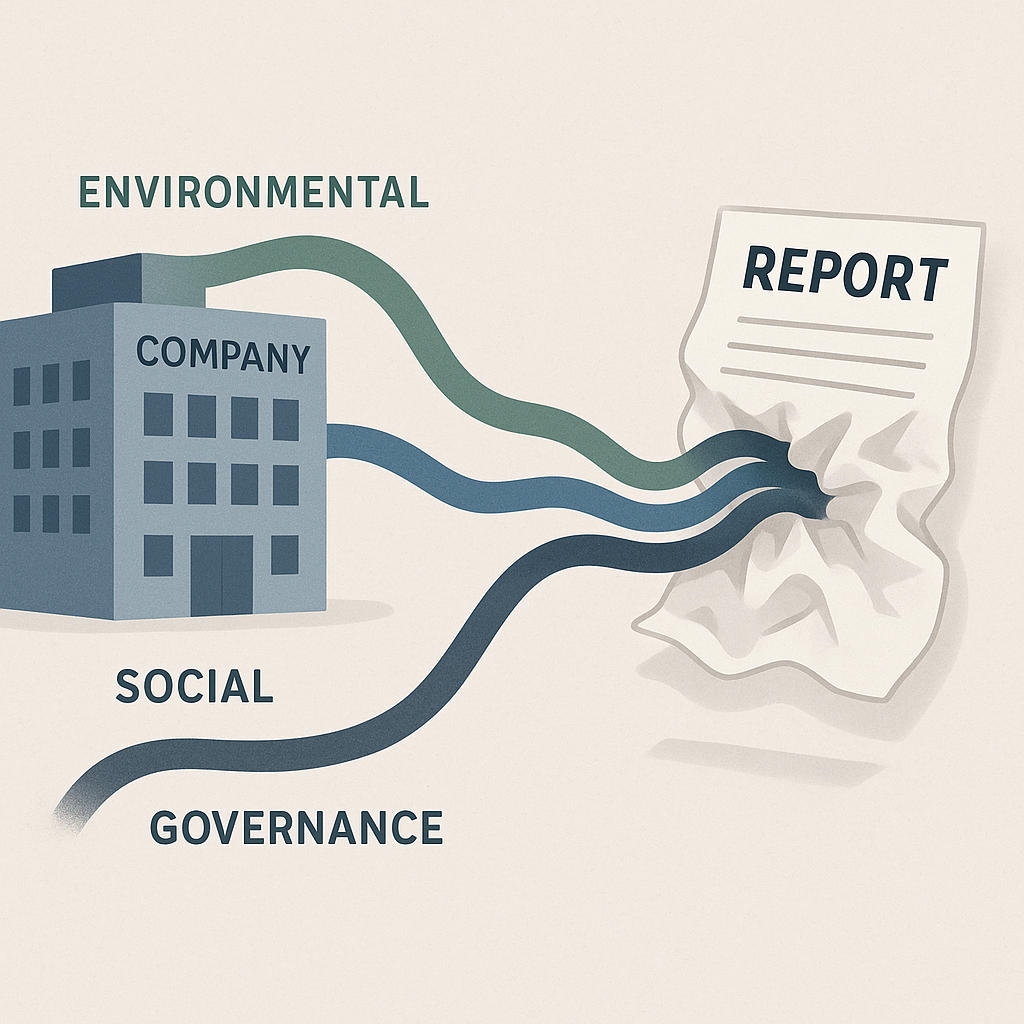
Table of Contents
For many finance leaders, the mandate for Environmental, Social, and Governance (ESG) reporting feels like yet another compliance burden dropped onto their already overflowing plates. The focus immediately jumps to the output: the final report, the specific metrics, the required disclosures. This approach is fundamentally misguided.
A perspective forged through decades of untangling enterprise data systems suggests that ESG is, first and foremost, a data architecture problem. The final report is merely the last step in a long, incredibly complex data journey. If you don’t architect the journey correctly, the report will become a painful, manual, and perpetually inaccurate exercise that consumes far more resources than it should.
The Scattered Data Challenge
The fundamental challenge of ESG isn’t regulatory complexity (though that’s real). It’s that the required data is scattered across your entire organization, residing in systems that were never designed to communicate with each other. This creates what systems engineers call a “data federation” problem at enterprise scale.
Environmental data might live in operational systems that track energy consumption, in facilities management software, or even in supplier-managed spreadsheets that track your supply chain’s carbon footprint. Some of it exists in IoT sensors monitoring building systems, while other pieces are buried in vendor invoices and utility bills.
Social data is typically housed in your HCM platform (ADP Workforce Now, Workday, or similar), covering diversity metrics, employee turnover, safety incidents, and training completion rates. But it also extends to supplier diversity data, community investment tracking, and customer satisfaction metrics that might live in entirely different systems.
Governance data is often the least structured and most problematic. It’s found in board minutes, legal department records, risk management systems, and compliance tracking tools. Much of it exists as unstructured documents rather than queryable data fields.
Expecting to produce a reliable, auditable ESG report by manually pulling this information together each quarter isn’t just inefficient. It’s a recipe for version control nightmares, questionable accuracy, and audit findings.
The Architecture Solution
Insights distilled from numerous complex system deployments indicate that organizations succeeding with ESG are the ones treating it as a system integration challenge rather than a reporting exercise. They’re building what might be called an ESG Data Hub or Sustainability Data Mart that systematically extracts, transforms, and loads this information from source systems.
This isn’t just about compliance; it’s about control and strategic insight. Once you have a trusted, unified source of ESG data, you can move beyond simple regulatory reporting. You can start performing real analysis, modeling the financial impact of sustainability initiatives, and providing leadership with the data they need to make informed strategic decisions.
The technical architecture typically involves:
Building APIs or data connectors to pull information from source systems automatically. Creating standardized data models that can accommodate different reporting frameworks (GRI, SASB, TCFD). Implementing data quality checks and validation rules to catch inconsistencies before they reach the final report.
The Dashboard Imperative
Here’s where most organizations miss a critical opportunity: they build the data infrastructure but stop short of creating meaningful visualization and analysis capabilities. The same data that feeds your regulatory reports should power executive dashboards that track ESG performance in near real-time.
PowerBI or Tableau dashboards can transform your ESG data from a quarterly compliance exercise into ongoing strategic intelligence. Imagine being able to correlate diversity hiring trends with business performance metrics, or tracking the ROI of sustainability investments across different business units. This kind of analysis becomes possible once you’ve solved the underlying data architecture challenge.
Beyond Compliance Thinking
The finance teams that will thrive in this new reporting environment are the ones who recognize that ESG represents a fundamental expansion of what “financial” data includes. Environmental costs, social risks, and governance failures all have direct financial implications that need to be measured, tracked, and managed like any other business metric.
Before you hire another consultant to help you write your ESG report, take a hard look at your data architecture. The solution isn’t found in a policy document or a reporting template. It’s found in the APIs, the data warehouses, and the governance frameworks that can connect your disparate systems into a coherent, auditable whole.
The organizations that get this right won’t just meet their reporting obligations. They’ll gain a competitive advantage through better visibility into the operational and financial drivers that ESG metrics actually represent.
For more discussion on architecting solutions for modern financial reporting demands, connect with me on LinkedIn.